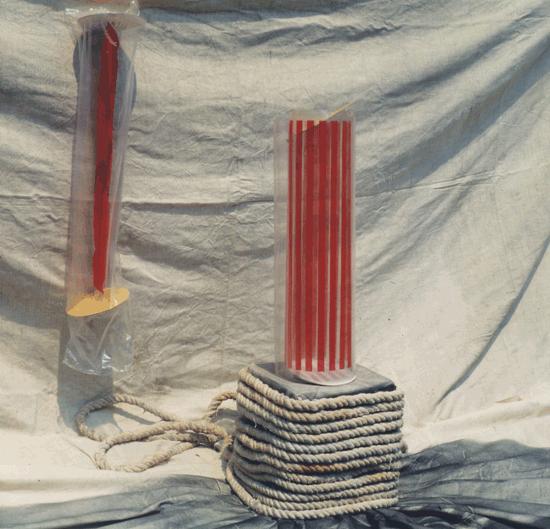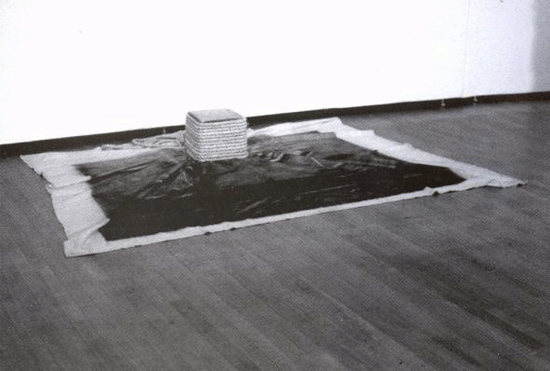Object & Installation

형의 상관
1972, 가변설치 (광목 천, 로프, 나무, 목탄), 천 크기 243X148cm, 나무 크기 31x31x31cm, 국립현대미술관 소장
강국진은 1970년대 초엽부터 천과 로프 등을 사용하면서 사물 자체, 사물과 사물 및 인간과 사물에 대한 상관관계를 보다 깊이 탐구하게 시작했으며 장소의 문제도 중요하게 고려하기 시작했다. 전시장 바닥에 31x31x31cm의 나무토막이 놓여지고 그 위에 정방형으로 목탄이 칠해진 흰 광목 천이 펼쳐져 있으며, 중앙에 놓인 나무토막으로 인해 불쑥 튀어나온 부분은 로프로 감겨있다. 제1회 ‘앙데팡당전’에 출품했던 작품과 같은 형태이나, 광목 천에 검은 목탄이 칠해져서 더욱 강렬하고 묵상적인 인상이다. 바닥에 펼쳐진 광목 천의 ‘평평함’과 로프로 감아 강조된 부분의 ‘돌출됨’이 각각 상이한 ‘형’(形)들을 이룬다. 그러나 강국진은 돌출되어 ‘입체’로 보이는 부분이 ‘평평한’ 광목 천의 연장일 뿐이며, 위상수학적으로 그것들이 동일한 ‘형’(形)임을 주목하는 듯하다. ‘한국미술협회’가 주최했던 제1회 ‘앙데팡당전’은 이우환이 단독 커미셔너로서 파리 비엔날레 등 국제 전시를 겨냥하여 작품을 선정했던 전시였다. 당시는 이우환이 사상적 뿌리를 제공했던 일본의 모노하 (ものは)와 이탈리아의 아르테 포베라 (Arte Povera), 포스트 미니멀 아트 (Post Minimal Art) 및 프랑스의 쉬포르 쉬르파스 (Supports/Surfaces)가 파리 비엔날레에서 첨예하게 만나던 시기였다. 68혁명의 물결과 함께 서구 모더니즘의 환원적 자기분석과 예술 창조의 자기 우상화에 대한 비판이 유럽 전역을 뒤흔들었던 무렵이다. 특히 1970년대 초엽 강국진의 탐색은 모노하 (ものは)의 범주로 집약되었던 이우환 및 스가 키시오 (菅木志雄) 등의 모색과 일맥 상통한다는 점에서 더욱 많은 한술적 연구를 필요로 한다. (김미경, 미술사학 박사 / 강남대 교수 / 한국예술연구소KARI 대표)
Interrelation of Forms
1972, Variable installation (white cotton cloth, rope, wood charcoal), cloth 243X148cm, wood 31x31x31cm, the National Museum of Contemporary Art Korea collection
Kukjin Kang started probing deeper into the realm of interrelationships between different objects, objects and human, and of the object itself in substance. In doing so, he utilized a range of materials such as ropes and cloths, and of course the locational matters in given spatial conditions. For instance, in one of Kang’s works ‘Interrelation of Forms’, he uses a wooden piece sized 31x31x31cm and there is a broad white cotton cloth, exactly square-shaped, with charcoal smudged on it. The large cloth is covering the entire body of the wood and the protruded area of it is accentuated with a rope around the area. The work as a whole gives off somewhat more strict and fierce impression than the first of its kind from the first ‘Indepandant Exhibition’, mainly because of the visual presence of the charcoal marks. It also has a comparative ‘formative’ sense in which the protrusion and the effect of rope is made differentiated from the flatness of the rest of the white cloth. One could find an example of this in Kang’s experience of Japanese Mono-ha (for which Ufan Lee thought up the fulcrum), Arte Povera of Italy, Post Minimal Art and Supports/Surfaces of France, who all encountered each other at Paris Biennale. For Kang’s work consisted of components that enabled to the whole to be considered in the same context as the above art phenomena of different countries. At the first ‘Indepandant Exhibition’ for which Ufan Lee participated as the sole commissioner, Kang’s topological illation in this context was shown by his display of a work that consisted of a sizable wood piece(31x31x31cm) covered with a broad white-cotton cloth. This was when the European mannerism in creation of art and reductive analysis of selves came to make their own factions alongside with 1968 revolution that swept the planet. Kang’s work from this part of history requires more academic investigation since the above journey of Kang has contextual connections with Mono-ha of Ufan Lee and Kisio Suga. (Mikyung Kim / Professor of Art History at Kangnam University / Director of Korean Art Research Institute)
KUKJIN KANG









